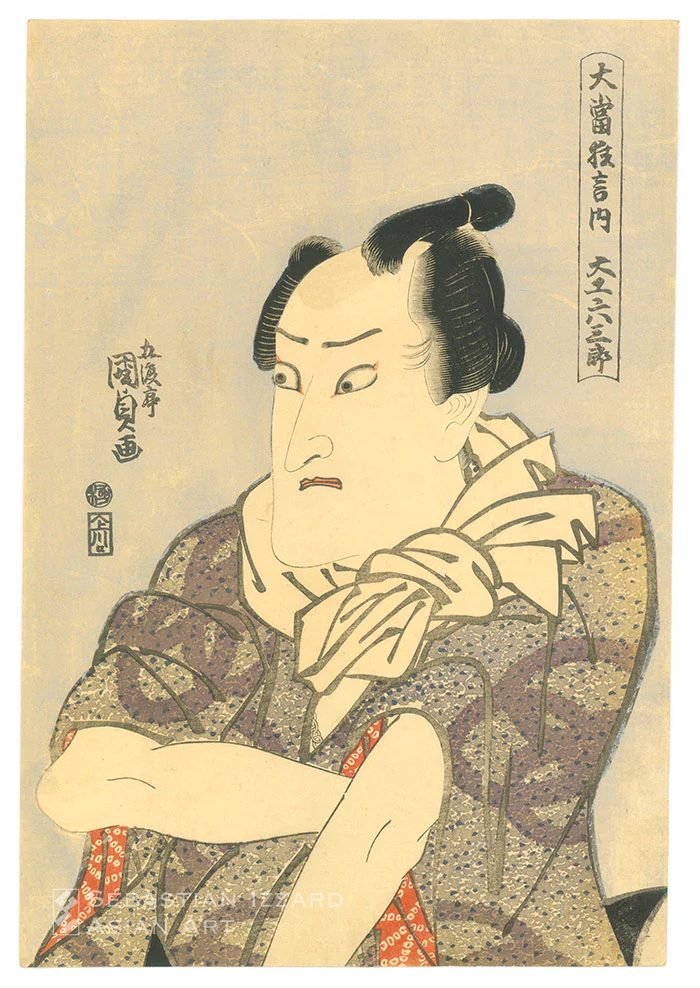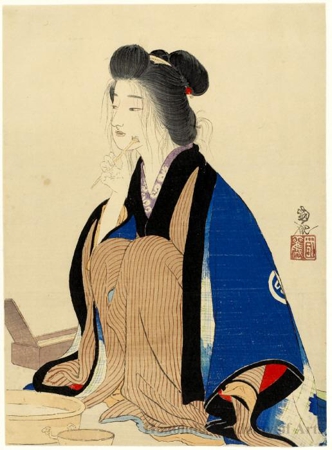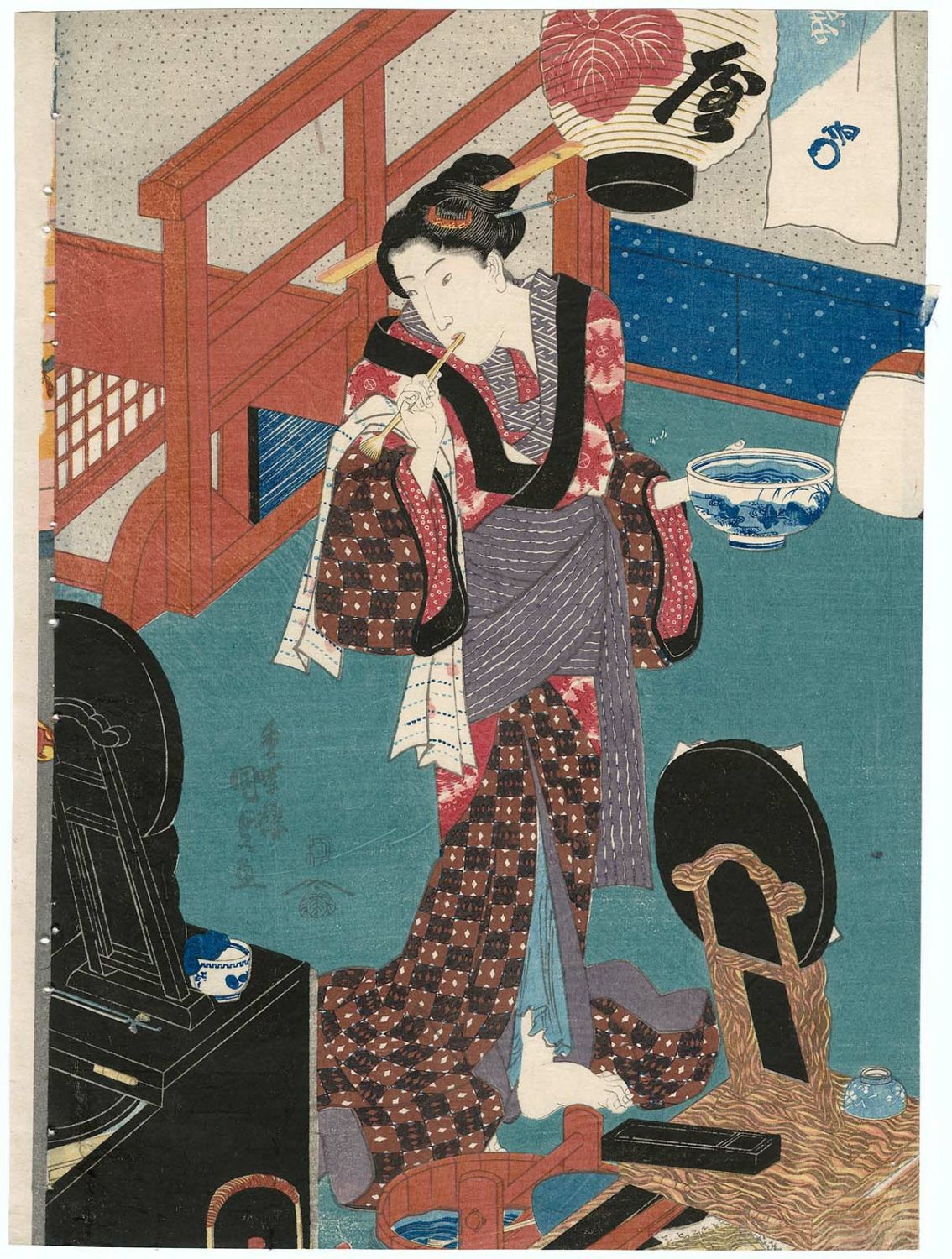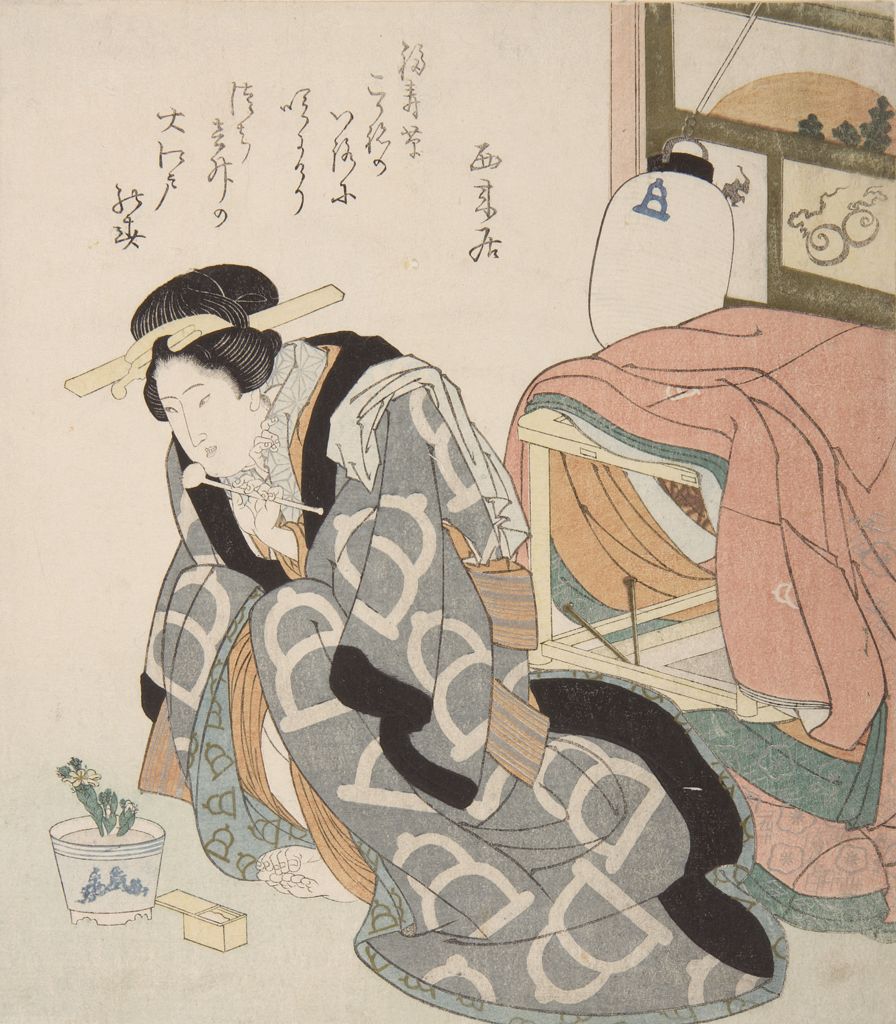Title-page: JAPANESE ART | Properties from | JAPAN SOCIETY, INC., N.Y. | MARY GRIGGS BURKE | A LADY | A EUROPEAN PRIVATE COLLECTION | AND FROM VARIOUS SOURCES | Auction | Thursday, 24 April 1997 at 11.00 a.m. approx. (Lots 60-194) | and at 2.00 p.m. (Lots 195-340) | 502 Park Avenue at 59th Street | New York, New York 10022 | Sale Code | In sending written bids or making inquiries, this sale should be referred to as #8670 | Viewing | […] |Christie's | 502 Park Avenue at 59th Street | New York, New York 10022 | Telephone: (212) 546 1000 | Internet: | http://www.christies.com | (40) Registered at the above address No. 1128160 | {CHRISTIE'S device} ||
Sixteen Fan Prints in this catalogue. 248. KUNIYOSHI: aiban uchiwa-e (22.5 × 29.4 cm.); entitled Hana no nishiki "Flower brocade", a half-length portrait of a beauty on a peony-decorated ground", signed Kuniyoshi ga and dated 4/1855—very good impression and color, some minute worm holes, binding holes on right. — Estimate: $2,500–3,500. 280. HIROSHIGE: aiban yoko-e, uchiwa-e (21.8 x 28.4 cm.); Tokaido, zuso Hakone sanchō kosui no zu “View of the lake in mountains at Hakone on the Tokaido between Izu and Sagami province”, and subtitled Bōsetsu “Evening snow”, from the series Omote ura chiji hakkei “Eight views of stations of the Tokaido and Kiso-kaidō”, signed Hiroshige ga—very good impression and color, faint vertical center fold restored on reverse, slightly soiled near corners. PROVENANCE: Theodor Scheiwe, sold in these Rooms, March 21, 1989, lot 264. PUBLISHED: Rose Hempel, Ausstellung Japanische Holzschnitte (Munster, 1959), no. 244, p. 145; Rose Hempel, Kunst Aus Japan (Essen: Villa Hügel, 1972), no. 496, p. 273; For another impression see Suzuki Juzo, Hiroshige (Tokyo: Nihon keizai shimbun, 1970), pl. 46. — Estimate: $10,000-15,000. 281. HIROSHIGE: aiban uchiwa-e (22.2 x 28.1 cm.); Yotsuya Shinjuku tsutsumi no hana “Cherry blossoms on the bank at Shinjuku, Yotsuya”, three women on a terrace overlooking cherry blossoms on the opposite bank in the night, signed Hiroshige ga, dated 1856, second month, and published by Ibaya Senzaburo—very good impression, color and condition. —Estimate: $8,000-10,000. 282. HIROSHIGE: aiban uchiwa-e (21.9 × 29.2 cm.); Sugita no baien "Plum garden at Sugita", signed Hiroshige ga and published by Sanoya Kihei—very good impression and color, binding holes on right restored, a minute repair on lower left. — Estimate: $8,000-10,000. 283. HIROSHIGE: aiban uchiwa-e (22.2 × 29.7 cm.); Buya Tsukuda no isaribune "Fishing boats at Tsukudajima in Musashi province", from the series Shokoku meisho "Famous places in the various provinces", signed Hiroshige ga over the publisher’s seal, published by Dansendō [Ibaya Senzaburō]—very good impression and color, faint center fold reinforced on the reverse, margins slightly soiled. PROVENANCE: Alexis Rouart, sold American Art Association, New York, February 6, 1922, lot 210; This impression was sold in these Rooms, December 4, 1984, lot 212. — Estimate: $10,000-15,000. 284. HIROSHIGE: aiban uchiwa-e (22.6 × 29 cm.); a tree and branches of yaezakura (double cherry blossoms) on a yellow background, signed Hiroshige hitsu and published by Dansendō [Ibaya Senzaburō]—very good impression and color, slightly stained, restoration on right. EXHIBITED: Pratt Graphics Center, New York, "Hiroshige: An exhibition of selected prints and illustrated books" (February 26—March 19, 1983); PUBLISHED: Sebastian Izzard, Hiroshige: An exhibition of selected prints and illustrated books (New York: The Ukiyo-e Society of America, 1983), no. 77. — Estimate: $6,000-8,000 285. HIROSHIGE: aiban uchiwa-e (23.2 × 29.4 cm.); Rokugo no watashi "The ferry at Rokugō", from the series Meisho fūkei "Famous landscapes", signed Hiroshige ga—very good impression and color, a worm hole in lower left margin, pasted on paper on upper corners; EXHIBITED: Pratt Graphics Center, New York, "Hiroshige: An exhibition of selected prints and illustrated books" (February 29—March 19, 1983); PUBLISHED: Sebastian Izzard, Hiroshige: An exhibition of selected prints and illustrated books (New York: The Ukiyo-e Society of America, 1983), no. 60. — Estimate: $6,000-8,000. 286. HIROSHIGE: aiban uchiwa-e (21.9 × 29 cm.); Shinshu, Suwako yukihare "Clear weather after snow at Lake Suwa in Shinano province", from the series Fuji sanjūrokkei no uchi "The thirty-six views of Mount Fuji", signed Hiroshige ga, dated 1842, and published by Ibaya Kyubei—very good impression and color, margins slightly soiled, vertical center fold restored.. EXHIBITED: Pratt Graphics Center, New York, "Hiroshige: An exhibition of selected prints and illustrated books" (February 29—March 19, 1983). PUBLISHED: Sebastian Izzard, Hiroshige: An exhibition of selected prints and illustrated books (New York: The Ukiyo-e Society of America, 1983), no. 51. — Estimate: $5,000-7,000. 287. HIROSHIGE: aiban uchiwa-e (22.4 × 28.7 cm.); Kodai buto "Classical dance", signed Ryūsai and published by Maruya Seijiro—good impression and color, slightly foxed, some minor worm holes, slightly creased, mat stain along edges, pasted on paper on upper corners, minor tear on upper edge. — Estimate: $3,000-4,000. 288. HIROSHIGE: chūban uchiwa-e (24.6 × 18.6 cm.); Kai Kawaguchi kosui no zu "View of the lake at Kawaguchi in Kai province", signed Hiroshige hitsu—good impression and color, slightly soiled, faint vertical center fold, binding holes on right restored. — Estimate: $3,000-4,000. 289. HIROSHIGE: aiban uchiwa-e (22.8 × 28.2 cm.); Karasaki no hitotsu matsu "Single pine tree at Karasaki", from the series Omi hakkei "Eight views of Lake Biwa", signed Hiroshige ga, dated 1852, seventh month, and published by Enshuya Matabei—very good impression and color, minute stains in lower right, pin holes on upper corners, vertical center fold. — Estimate: $5,000-7,000. 290. HIROSHIGE: aiban uchiwa-e (23.4 × 30 cm.); three stems of peonies on a blue background, signed Hiroshige ga, dated 1857, second month, and published by Marukyudo—very good impression and color, holes on right restored, some minor worming restored, otherwise good condition. EXHIBITED: Pratt Graphics Center, New York, "Hiroshige: An exhibition of selected prints and illustrated books" (February 26—March 19, 1983). PUBLISHED: Sebastian Izzard, Hiroshige: An exhibition of selected prints and illustrated books (New York: The Ukiyo-e Society of America, 1983), no. 76. — Estimate: $10,000-15,000. 291. HIROSHIGE: aiban uchiwa-e (22 × 29.8 cm.); Kodai meiyo shiki no hana "Flowers of the four seasons with historical associations", subtitled Natsu, Mikawa Yatsuhashi no tojaku "Summer, Iris at Yatsuhashi in Mikawa province" and a rectangular cartouche with a portrait of the poet Ariwara no Narihira, signed Hiroshige ga and published by Surugaya—very good impression and color, margins slightly soiled, binding holes on left restored. EXHIBITED: Pratt Graphics Center, New York, "Hiroshige: An exhibition of selected prints and illustrated books" (February 26—March 19, 1983). PUBLISHED: Sebastian Izzard, Hiroshige: An exhibition of selected prints and illustrated books (New York: The Ukiyo-e Society of America, 1983), no. 52. — Estimate: $10,000-15,000. 292. HIROSHIGE: aiban uchiwa-e (22.1 × 26 cm.); a seated woman taking a sake cup from a boat-shaped porcelain bowl under a night river landscape with full-moon, signed Hiroshige ga, dated 1852, fourth month, and published by Ibaya Senzaburo—very good impression and color, slightly stained, a minute worm hole restored. EXHIBITED: Pratt Graphics Center, New York, "Hiroshige: An exhibition of selected prints and illustrated books" (February 29—March 19, 1983). PUBLISHED: Sebastian Izzard, Hiroshige: An exhibition of selected prints and illustrated books (New York: The Ukiyo-e Society of America, 1983), no. 69. — Estimate: $4,000-6,000. 312. HIROSHIGE II: aiban uchiwa-e (22.7 × 29.1 cm.); an aizuri-e “blue print”, Tsunohazu juniso otaki “Great waterfall of the twelve shrines at Tsunohazu”, signed Hiroshige ga, dated 1861—very good impression and color, corners slightly soiled, binding holes and minor worming on left restored. PROVENANCE: A. Maroni. — Estimate: $4,000-6,000. 313. HIROSHIGE II: aiban uchiwa-e (22.7 × 29.7 cm.); Owari, Atsuta kaigan “Atsuta Beach in Owari province”, from the series Shokoku meisho zue “Illustrations of famous places in the various provinces”, signed Hiroshige ga, seal dated [1862], and published by Iseya Soemon—very good impression and color, slightly browned along lower edge. — Estimate: $8,000-10,000.-
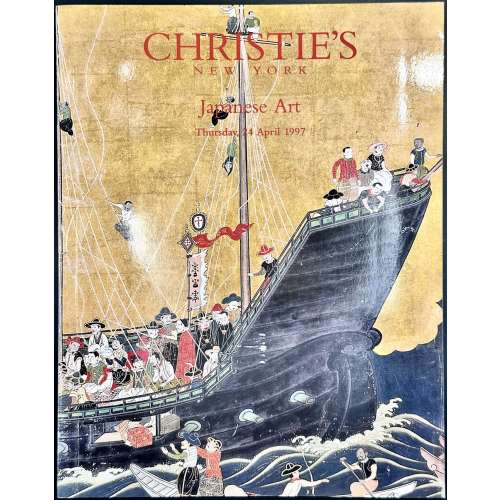 NEWSoftcover auction catalogue, 267 x 209 mm, pictorial wrappers with red lettering to cover, black and white lettering to spine; pp. [2] 3-179 [1]; auction held at Christie’s New York on Thursday, 24 April 1997, featuring lots 60-340, with properties from Japan Society, Inc., N.Y., Mary Griggs Burke, a lady, a European private collection, and various sources; includes descriptions and images of Japanese paintings, prints, ceramics, lacquer, and other works of art.
NEWSoftcover auction catalogue, 267 x 209 mm, pictorial wrappers with red lettering to cover, black and white lettering to spine; pp. [2] 3-179 [1]; auction held at Christie’s New York on Thursday, 24 April 1997, featuring lots 60-340, with properties from Japan Society, Inc., N.Y., Mary Griggs Burke, a lady, a European private collection, and various sources; includes descriptions and images of Japanese paintings, prints, ceramics, lacquer, and other works of art. -
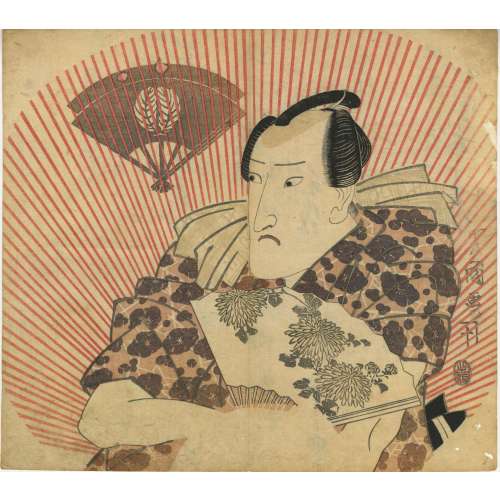 NEW
NEWArtist: Utagawa Toyokuni I [初代豊国] (Japanese, 1769–1825)
Signed: Toyokuni ga [豊国画]
Publisher: Kojimaya Jūbei [小嶋屋重兵衛] (Japanese, c. 1797–1869); seal [十]; Marks 06-014 | 264a
Date-Aratame Seal: 1822 (Bunsei 5, 文政五年)
Media: Print (Uchiwa-e, うちわ絵, fan print); 223 × 250 mm
Actor: Onoe Kikugorō III [三代目 尾上菊五郎] (Japanese, 1784–1849); other names: Onoe Baikō III (尾上梅幸), Ōkawa Hashizō I (大川橋蔵初代), Onoe Matsusuke II (二代目尾上松助), Onoe Eizaburō I (初代尾上栄三郎)
Half-length, three-quarter-view portrait of Onoe Kikugorō III, depicted without stage makeup. The actor wears a kimono patterned with plum blossoms (梅, ume), symbolising perseverance and longevity. A neck scarf with a 格子 (kōshi) pattern is visible, and he holds a folding fan (扇, ōgi) decorated with chrysanthemums (菊, kiku).
Above his head is the Onoe family crest (mon), embracing oak leaves on layered fans. This emblem, known as the crest of the Otowaya line, commemorates a shogunal gift of rice cakes wrapped in oak leaves, placed on a fan, and presented to Onoe Kikugorō I.
The background features a radiating red-line pattern, possibly representing the bamboo structure of an uchiwa fan. The absence of kumadori (歌舞伎隈取, kabuki makeup) suggests that the actor is not portrayed in a specific role.
In 1822, Onoe Kikugorō III performed at Kawarazaki-za before month 11 and at Ichimura-za and Nakamura-za afterwards.
The print has been backed for preservation with a sheet of paper featuring calligraphy, likely contemporary to the print itself. The backing paper appears to have been repurposed, a common historical practice in the Edo period, where discarded documents or manuscripts were reused to reinforce delicate prints.
Kunisada portrayed the same actor in 1815 as Rokusaburō, the Carpenter (Daiku Rokusaburō).
-
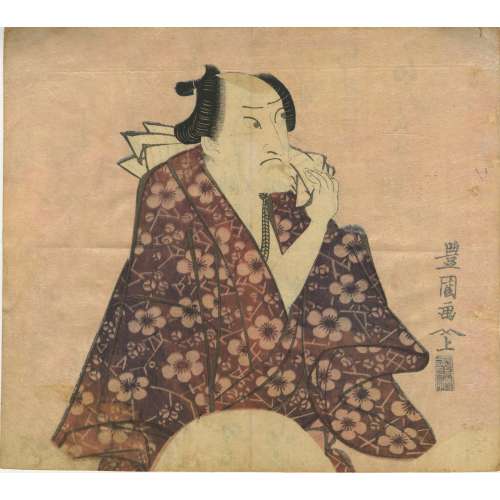 NEWArtist: Utagawa Toyokuni I [初代豊国] (Japanese, 1769–1825) Signed: Toyokuni ga [豊国画] Publisher: Iseya Sōemon [伊勢屋惣右衛門] (c. 1776 – November 1862); Marks 02-041 | 156a Gyōji Aratame Seal: 1815 (Bunka 12, 文化十二年)1 Media: Print (Uchiwa-e, うちわ絵, fan print), kira-zuri (きら摺り, mica printing); 222 × 250 mm
NEWArtist: Utagawa Toyokuni I [初代豊国] (Japanese, 1769–1825) Signed: Toyokuni ga [豊国画] Publisher: Iseya Sōemon [伊勢屋惣右衛門] (c. 1776 – November 1862); Marks 02-041 | 156a Gyōji Aratame Seal: 1815 (Bunka 12, 文化十二年)1 Media: Print (Uchiwa-e, うちわ絵, fan print), kira-zuri (きら摺り, mica printing); 222 × 250 mmActor: Onoe Baikō III [三代目尾上梅幸] (Japanese, 1784–1849); Other names: Onoe Kikugorō III (尾上菊五郎), Ōkawa Hashizō I (大川橋蔵初代), Onoe Matsusuke II (二代目尾上松助), Onoe Eizaburō I (初代尾上栄三郎)
Role: Konjin Chōgorō (金神長五郎) Play: Ku Kyōdai Shōbu Katabira (句兄弟菖蒲帷子) Theater: Nakamura-za (中村座), Edo, 1815 Half-length, three-quarter-view, facing to the left portrait of Onoe Baikō III as Konjin Chōgorō, in the play Ku Kyōdai Shōbu Katabira, staged at Nakamura-za in 1815. The actor wears a purple kimono with a plum blossom motif (梅, ume).A print from the Waseda University Tsubouchi Memorial Theatre Museum also depicts Onoe Baikō III as Konjin Chōgorō, showing him holding a box inscribed with 神金 (Kane no Kami). The name Konjin consists of the same kanji in reverse order (金神).
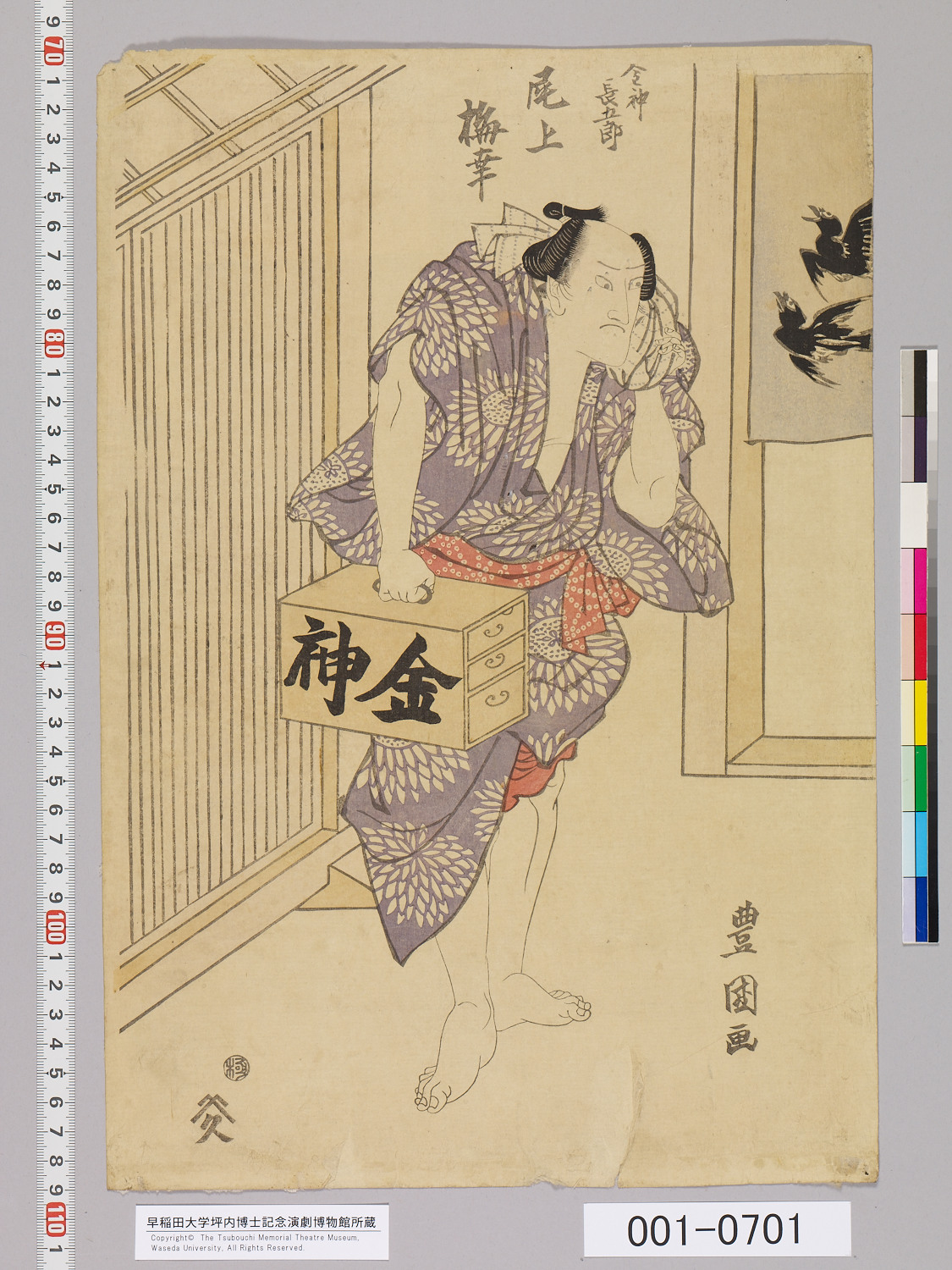
Konjin Chōgorō is a legendary figure in Japanese folklore, renowned as a formidable sumo wrestler. His tales often depict him engaging in supernatural feats, such as vanquishing demons and showcasing extraordinary strength.
In the realm of kabuki theatre, Konjin Chōgorō's character has been portrayed in various plays, though specific details about Ku Kyōdai Shōbu Katabira (句兄弟菖蒲帷子) remain unknown.
Notes
-
A certain confusion regarding the attribution of this print arises from the statement by Andreas Marks (Publishers, 2011, p. 488), which asserts that the gyōji aratame seal was used exclusively for fan prints between 1810 and 1814. However, it is known that Onoe Baikō III performed the role of Konjin Chōgorō at Nakamura-za in the 5th month of 1815. Marks also notes that the earliest known fan print bearing this seal dates to 1810; based on this new evidence, we may now consider the latest known instance to be the 5th month of 1815.
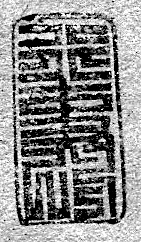
-
-
 NEWArtist: Utagawa Toyokuni I [初代豊国] (Japanese, 1769–1825) Signed: Toyokuni ga [豊国画]. Publisher: Iseya Sōemon [伊勢屋惣右衛門] (c. 1776 – November 1862); Marks 02-041 | 156a Date-Aratame Seal: 1819 (Bunsei 2, 文政二年) Media: Print (Yakusha-e, 役者絵); 221 × 253 mm Play: Ume Yanagi Wakaba no Kagazome (梅柳若葉加賀染) Theater: Tamagawa-za (玉川座), Edo, May 1819 Role: Kurenaiya Okan (紅屋おかん) Actor: Segawa Kikunojō V [瀬川菊之丞] (Japanese, 1802–1832); Other name: Segawa Tamon I (瀬川多聞初代) Bust-length, three-quarter-view portrait of Segawa Kikunojō V as Kurenaiya Okan in the play Ume Yanagi Wakaba no Kagazome, staged at Tamagawa-za in May 1819. The male actor Segawa Kikunojō V performs an onnagata role, portraying a courtesan. She is depicted adjusting her elaborate shimadamage-style coiffure, fixing a kanzashi (簪, hairpin) while holding onkotogami (御懲紙, tissue paper) in her mouth. The onkotogami was traditionally used for intimate hygiene, suggesting that the scene represents a moment after encountering a client. Her inner kimono is safflower-dyed and has a hemp leaf pattern (麻の葉, asa no ha). The top half of the background features a giant golden carp (鯉, koi), a recurring motif in this pair of prints often associated with strength, perseverance, and kabuki’s aragoto style. This print forms a pair with the portrait of Ichikawa Danjūrō VII as Yushima no Sankichi [SVJP-0439.2025], but no conclusive information is available regarding the relationship between their characters. The carp also alludes to Boys' Day (Tango no Sekku, 端午の節句), celebrated on May 5th each year.
NEWArtist: Utagawa Toyokuni I [初代豊国] (Japanese, 1769–1825) Signed: Toyokuni ga [豊国画]. Publisher: Iseya Sōemon [伊勢屋惣右衛門] (c. 1776 – November 1862); Marks 02-041 | 156a Date-Aratame Seal: 1819 (Bunsei 2, 文政二年) Media: Print (Yakusha-e, 役者絵); 221 × 253 mm Play: Ume Yanagi Wakaba no Kagazome (梅柳若葉加賀染) Theater: Tamagawa-za (玉川座), Edo, May 1819 Role: Kurenaiya Okan (紅屋おかん) Actor: Segawa Kikunojō V [瀬川菊之丞] (Japanese, 1802–1832); Other name: Segawa Tamon I (瀬川多聞初代) Bust-length, three-quarter-view portrait of Segawa Kikunojō V as Kurenaiya Okan in the play Ume Yanagi Wakaba no Kagazome, staged at Tamagawa-za in May 1819. The male actor Segawa Kikunojō V performs an onnagata role, portraying a courtesan. She is depicted adjusting her elaborate shimadamage-style coiffure, fixing a kanzashi (簪, hairpin) while holding onkotogami (御懲紙, tissue paper) in her mouth. The onkotogami was traditionally used for intimate hygiene, suggesting that the scene represents a moment after encountering a client. Her inner kimono is safflower-dyed and has a hemp leaf pattern (麻の葉, asa no ha). The top half of the background features a giant golden carp (鯉, koi), a recurring motif in this pair of prints often associated with strength, perseverance, and kabuki’s aragoto style. This print forms a pair with the portrait of Ichikawa Danjūrō VII as Yushima no Sankichi [SVJP-0439.2025], but no conclusive information is available regarding the relationship between their characters. The carp also alludes to Boys' Day (Tango no Sekku, 端午の節句), celebrated on May 5th each year.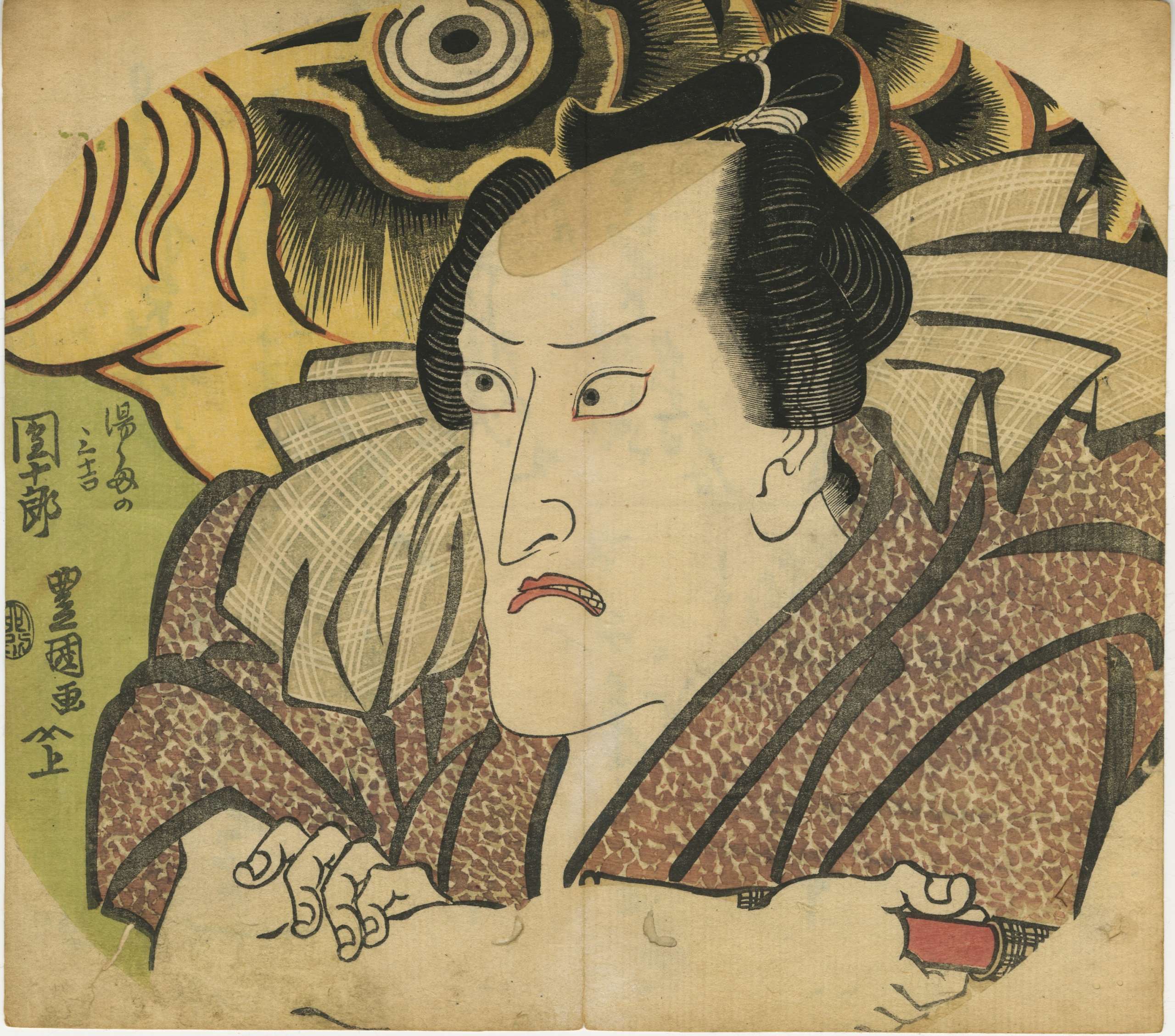
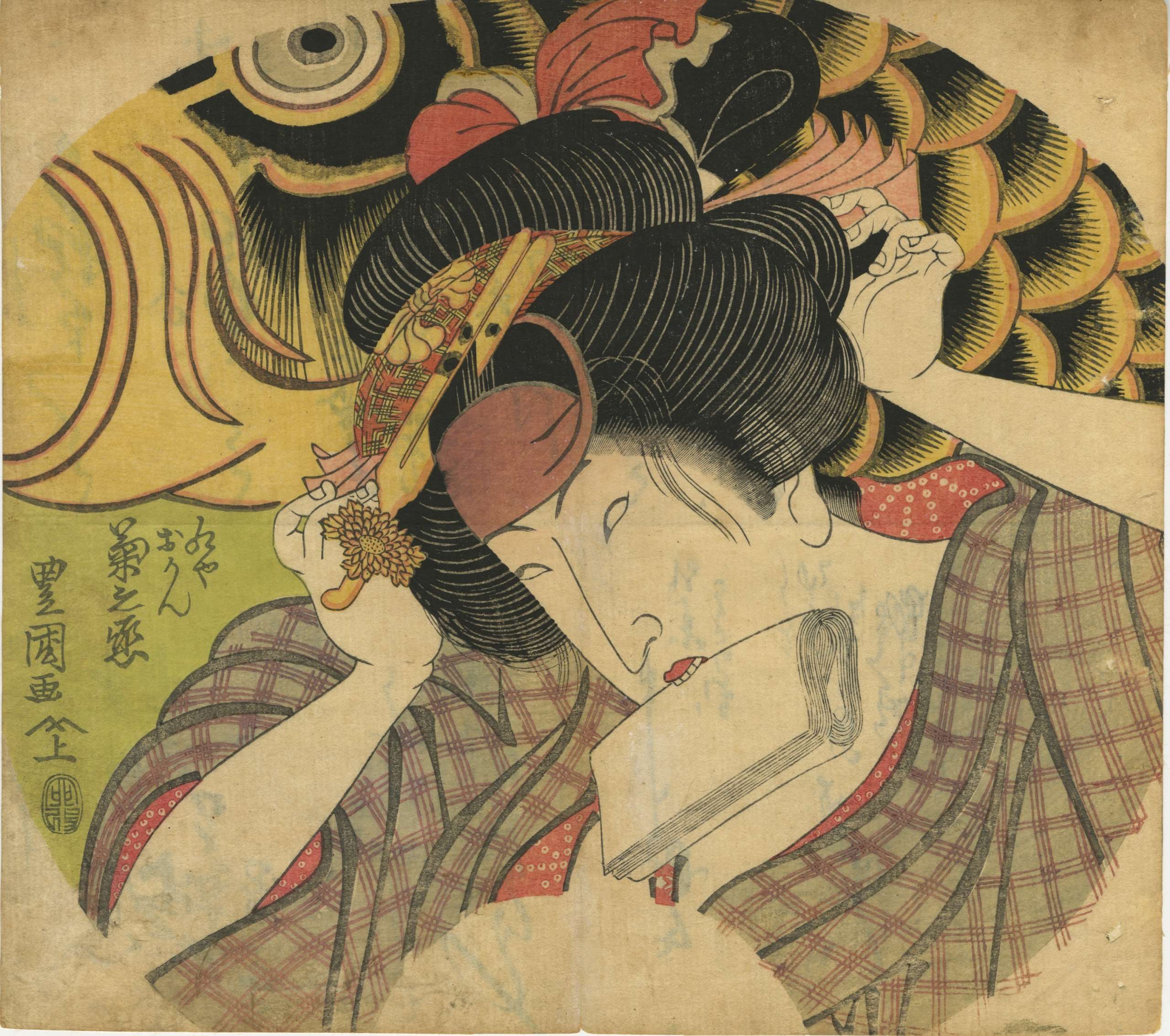
-
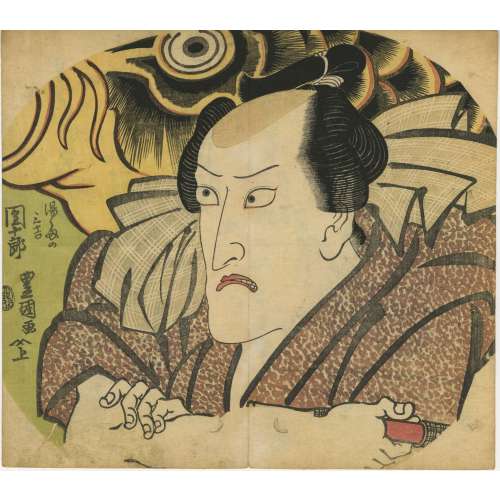 NEWArtist: Utagawa Toyokuni I [初代豊国] (Japanese, 1769–1825) Signed: Toyokuni ga [豊国画]. Publisher: Iseya Sōemon [伊勢屋惣右衛門] (c. 1776 – November 1862); Marks 02-041 | 156a Date-Aratame Seal: 1819 (Bunsei 2, 文政二年) Media: Print (Yakusha-e, 役者絵); 221 x 253 mm
NEWArtist: Utagawa Toyokuni I [初代豊国] (Japanese, 1769–1825) Signed: Toyokuni ga [豊国画]. Publisher: Iseya Sōemon [伊勢屋惣右衛門] (c. 1776 – November 1862); Marks 02-041 | 156a Date-Aratame Seal: 1819 (Bunsei 2, 文政二年) Media: Print (Yakusha-e, 役者絵); 221 x 253 mmActor: Ichikawa Danjūrō VII [七代目市川團十郎] (Japanese, 1791–1859); Other names: Ichikawa Ebizō V (五代目市川海老蔵), Ichikawa Hakuen II (二代目市川白猿), Ichikawa Shinnosuke I (初代市川新之助).
Role: Yushima no Sankichi (ゆしまの三吉) Play: Ume Yanagi Wakaba no Kagazome (梅柳若葉加賀染) Theater: Tamagawa-za (玉川座), Edo, May 1819 Bust-length, three-quarter-view portrait of Ichikawa Danjūrō VII as Yushima no Sankichi, in the play Ume Yanagi Wakaba no Kagazome, staged at Tamagawa-za in May 1819. The actor is depicted with his arms crossed over his chest, holding a pipe (kiseru, 煙管) in his right hand. The upper half of the background features a giant golden carp (鯉, koi), symbolizing Boys' Day (Tango no Sekku) (端午の節句), celebrated on May 5th each year. This print forms a pair with the portrait of Kabuki actor Segawa Kikunojō V as Kurenaiya Okan [SVJP-0440.2025], but no conclusive information is available regarding the relationship between their characters.

-
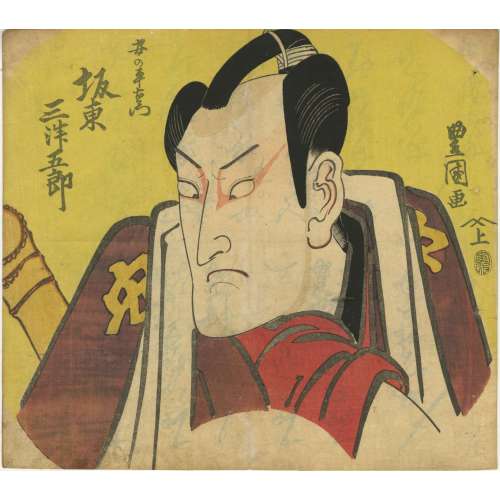 NEW
NEWArtist: Utagawa Toyokuni I [初代豊国] (Japanese, 1769–1825)
Publisher: Iseya Sōemon [伊勢屋惣右衛門] (c. 1776 – November 1862); Marks 02-041 | 156a
Date-Aratame Seal: Bunsei 1 (文政元年, 1818)
Media: Print (Yakusha-e, 役者絵); 223 x 250 mm
Actor: Bandō Mitsugorō III [三代目 坂東 三津五郎] (Japanese, 1775–1831); also known as Bandō Minosuke I, Morita Kanjirō II, Bandō Mitahachi I, Bandō Minosuke I, Bandō Mitahachi I.
Role: Anno Heiemon [安の平右衛門], also known as Anno Heibei [安の平兵衛].
Play: Shiire Zome Karigane Gomon [仕入染雁金五紋] (しいれぞめかりがねごもん), staged in May 1818 at Nakamuraza Theatre in Edo (modern-day Tokyo).
Bust-length, three-quarter-view portrait of actor Bandō Mitsugorō III as Anno Heibei, one of the gonin otoko [五人男]—a group of five chivalrous thieves. The actor is dressed in a red and purple robe, with a golden mon (family crest) on the shoulders, displaying the character 安 (An), which, in this case, represents the first ideogram in the name of his role. A shakuhachi (尺八), a traditional Japanese end-blown bamboo flute, is secured on his back.
-
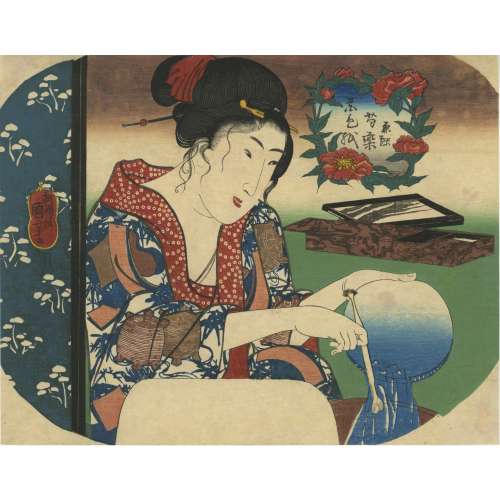 NEWPeonies (Shakuyaku) [芍薬] Series: Flower-Colored Papers (Hana Shikishi) [花色紙] Artist: Utagawa Kuniyoshi [歌川 國芳] (Japanese, 1798–1861) Signature: Chō-ō-rō Kuniyoshi ga (朝櫻楼 國芳 画) Publisher: Kojimaya Jūbei [小島屋 十兵衛] (Japanese, 1797 – 1869); seal 十, Marks 06-014 | 264a Date/Censorship Approval: Nanushi seal Yoshimura (吉村) for Yoshimura Gentarō (吉村 源太郎), VI/1843–XI/1846. Medium: Rigid fan print (Aiban Yoko-e Uchiwa-e, 合判横絵 団扇絵), 222 x 284 mm.
NEWPeonies (Shakuyaku) [芍薬] Series: Flower-Colored Papers (Hana Shikishi) [花色紙] Artist: Utagawa Kuniyoshi [歌川 國芳] (Japanese, 1798–1861) Signature: Chō-ō-rō Kuniyoshi ga (朝櫻楼 國芳 画) Publisher: Kojimaya Jūbei [小島屋 十兵衛] (Japanese, 1797 – 1869); seal 十, Marks 06-014 | 264a Date/Censorship Approval: Nanushi seal Yoshimura (吉村) for Yoshimura Gentarō (吉村 源太郎), VI/1843–XI/1846. Medium: Rigid fan print (Aiban Yoko-e Uchiwa-e, 合判横絵 団扇絵), 222 x 284 mm.Interpretation of the Inscription in the Floral Cartouche
- 花色紙 (Hana Shikishi) – "Flower-Colored Paper" or "Decorative Shikishi Paper with Floral Motifs"
- 芍薬 (Shakuyaku) – "Peony", a flower symbolizing prosperity, beauty, and romance in Japanese culture
- 団扇絵 (Uchiwa-e) – "Round Fan Illustration" or "Picture on an Uchiwa (rigid fan)"
Description & Symbolic Analysis
This print, part of the Hana Shikishi (Flower-Colored Papers) series, depicts a woman washing a basin after brushing her teeth. She is positioned behind an indigo-colored folding screen, adorned with a repeating pattern of distant pines, presented in reverse printing technique (wyabori, 捺ぼり). The screen is a visual separator, adding depth and an intimate atmosphere to the scene. The woman is portrayed in a three-quarter view, facing left, her face delicately contoured. She is dressed in a safflower-dyed kimono (furisode, 振袖) featuring an asanoha (麻の葉, hemp leaf) shibori pattern, a motif often associated with purity and protection. Over this, she wears an outer garment decorated with an indigo bamboo motif, symbolizing strength and resilience. Additionally, the garment features:- Double gourd (瓢箪, hyōtan) symbolises longevity, fertility, and good fortune.
- Strips of paper resembling “next-morning letters” (kinuginu no fumi, 衣衣の文) – These evoke romantic correspondence or the written wishes of the Tanabata festival.
- Spools or reels of thread (chikiri, 糸巻き) – A motif reminiscent of Tanabata festival themes, often linked to the celestial lovers Orihime and Hikoboshi. The phonetic pun with chigiri (契り, vow or romantic promise) reinforces themes of marriage, fate, and lifelong bonds.
Adornment & Hairstyling
Her elaborate hairstyle features a red hair tie (musubi, 結び), signifying youth and romantic allure. It is further adorned with:- Golden kogai (笄) – A decorative hairpin, often used by courtesans or high-ranking women.
- Tama kanzashi (玉簪) – A ball-tipped ornamental hairpin, reinforcing her refined status.
Objects in the Scene & Their Symbolism
The woman is holding a traditional Japanese toothbrush (fusa-yōji, ふさ楊枝) in her right hand, while pouring out water from the basin after brushing her teeth. This act symbolizes purity and preparation for intimacy. To her right, an ornate lacquered writing box (suzuribako, 硯箱) is placed near an inkstone (硯, suzuri). This object could also be interpreted as a dreamstone (梦石, mèng shí), a scholar’s object associated with nostalgia, love, or secret communication.Context in Ukiyo-e Tradition
Tooth brushing was uncommon in bijin-ga (美人画, "beautiful woman prints"). Ukiyo-e frequently depicted women engaging in personal grooming rituals, reflecting ideals of elegance and self-care in Edo-period culture.
Two additional fan prints from the Hana Shikishi series have been identified and can be found at the Kuniyoshi Project website:- Morning Glory (Asagao, 朝顔)
- Clematis (Tessen, 鉄線)
These prints, like Peonies (Shakuyaku), emphasize seasonal beauty and feminine refinement, themes central to Kuniyoshi’s bijin-ga oeuvre.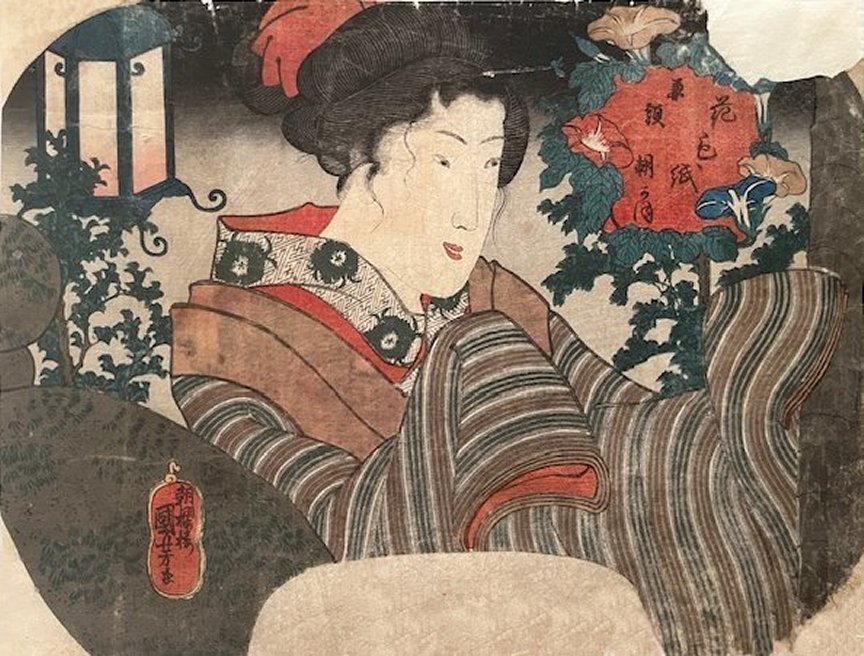
Morning Glory (Asagao, 朝顔)
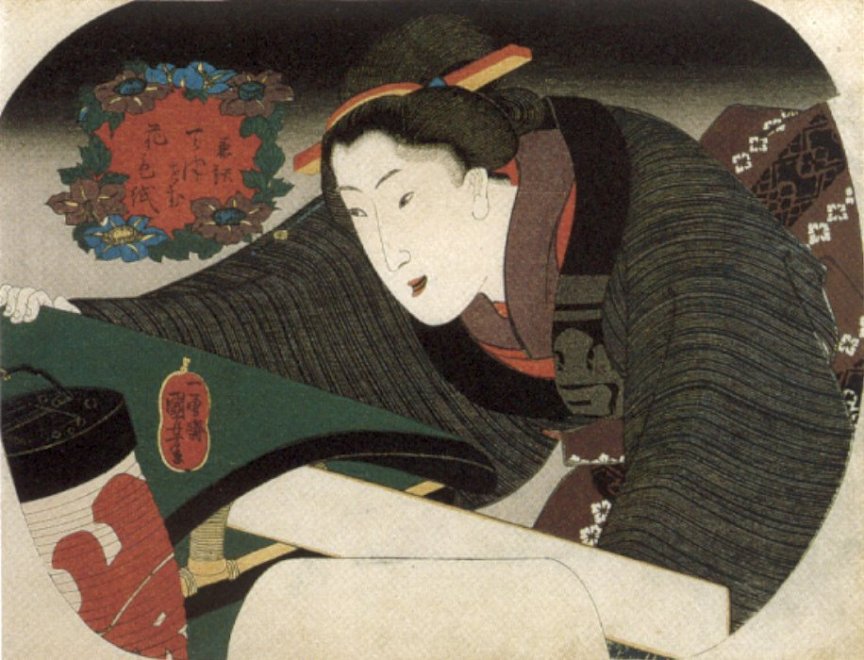
Clematis (Tessen, 鉄線)
-
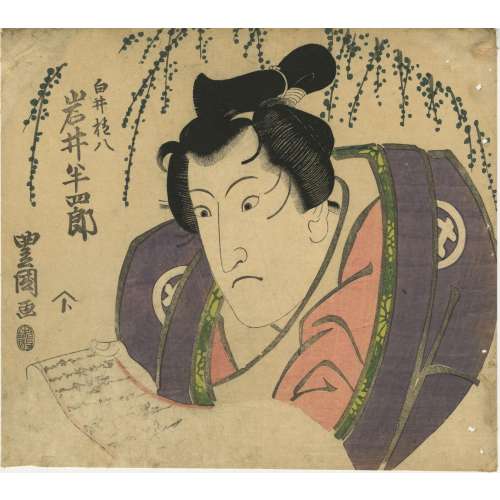 NEWKabuki actor Iwai Hanshiro V, in the role of Shirai Gonpachi, stands under a willow tree (yanagi, 柳) to read a letter from the courtesan Komurasaki of the Miuraya [三浦屋小紫]. In this letter, Komurasaki laments their unfortunate love. This is a scene from the kabuki play The Floating World's Pattern and Matching Lightning Bolts (Ukiyozuka hiyoku no inazuma) [浮世柄比翼稲妻] written by Tsurya Namboku IV [鶴屋南北]; it was played for the first time in March 1823 at Ichimura Theatre [市村座] in Edo. This play was later divided into two individual pieces: Saya-ate [鞘当] and Fuwa [不破]. On the shoulders of the actor's garment is a character 井 in a circle — both names, Iwai 岩井 and Shirai 白井, use this character.
NEWKabuki actor Iwai Hanshiro V, in the role of Shirai Gonpachi, stands under a willow tree (yanagi, 柳) to read a letter from the courtesan Komurasaki of the Miuraya [三浦屋小紫]. In this letter, Komurasaki laments their unfortunate love. This is a scene from the kabuki play The Floating World's Pattern and Matching Lightning Bolts (Ukiyozuka hiyoku no inazuma) [浮世柄比翼稲妻] written by Tsurya Namboku IV [鶴屋南北]; it was played for the first time in March 1823 at Ichimura Theatre [市村座] in Edo. This play was later divided into two individual pieces: Saya-ate [鞘当] and Fuwa [不破]. On the shoulders of the actor's garment is a character 井 in a circle — both names, Iwai 岩井 and Shirai 白井, use this character.
More information about the play and the real story behind it can be found at Lyon Collection. Actor: Iwai Hanshirō V [岩井半四郎] (Japanese, 1776 – 1847); other names: Iwai Tojaku, Iwai Kumesaburō I. Role: Shirai Gonpachi [白井権八] Artist: Utagawa Toyokuni I [歌川豊国] (1769–1825). Signed: Toyokuni ga [豊国画]. Publisher: Enshūya Matabei [遠州屋又兵衛] (Enterprise, active c. 1768 – 1881); seal: “to” (ト) under roof (Marks 01-031 | 057a). Date-aratame censor seal: 未改, Bunsei 6 (1823). Media: Aiban yoko-e uchiwa-e 団扇絵), 233 x 260 mm."Ukiyozuka Hiyoku no Inazuma" is a kabuki play in nine acts, written by Tsuruya Nanboku IV. It premiered in Bunsei 6 (1823) at the Ichimura-za theatre in Edo.
The play includes two particularly famous scenes:
- "Suzugamori no ba" (The Scene at Suzugamori), which portrays the episode of Banzuiin Chōbei and Shirai Gonpachi
- "Yoshiwara Nakanochō no ba" (The Scene at Yoshiwara Nakanochō), which depicts the story of Nagoya Sanza and Fuwa Banzaemon
These scenes have been frequently performed under the well-known titles "Gozonji Suzugamori" (A Well-Known Suzugamori) and "Sayaate" (The Scabbard Clash).
-
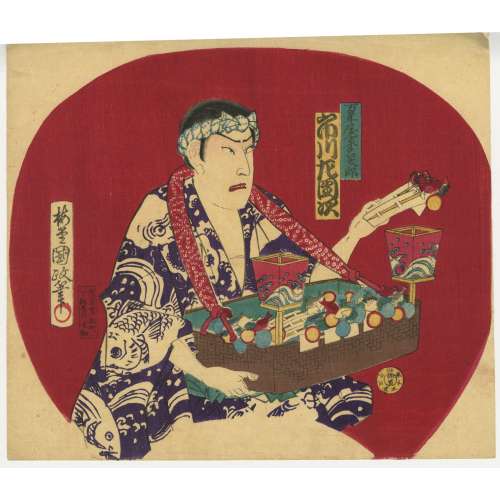 NEW
NEWTitle: Kabuki Actor Ichikawa Sadanji I as Mannenya Kamei Tarō
Artist: Utagawa Kunisada III (Baido Kunimasa) [Japanese, 1848–1920]
Signature: Baidō Kunimasa hitsu (梅堂國政筆)
Actor: Ichikawa Sadanji I (市川左団次, also known as Ichikawa Shōjaku I, Ichikawa Koyone, Ichikawa Tatsuzō) [Japanese, 1842–1904]
Role: Mannenya Kamei Tarō (万年屋家名太郎)
Play: Unidentified
Publisher: Shimōsaya Masukichi (下総屋升吉)
Publisher’s Address: Asakusa, Kurofune-chō (浅草 黒舩)
Date: [明治十三年三月] Meiji 13 (1880), 3rd month
Medium: Uchiwa-e (団扇絵, fan print), ink and colour on paper, 245 × 282 mmThis uchiwa-e (fan print) by Utagawa Kunisada III (also known as Utagawa Kunimasa IV) portrays the kabuki actor Ichikawa Sadanji I in the role of Mannenya Kamei Tarō. The figure is depicted in a dramatic stance, dressed in a striking blue kimono adorned with fish and wave motifs, suggesting a maritime or festival connection. He carries a large basket supported by a fabric strap around his neck, filled with small toy fish attached to sticks, along with round objects that could be festival sweets or miniature decorations. He holds one of these toy fish-on-a-stick items in his right hand, possibly demonstrating it as part of a vendor's performance.
The background is a bold, deep red, contrasting with the detailed rendering of the actor’s expression and costume. The print was published in 1897 (Meiji 30) by Shimōsaya Masukichi, a publisher based in Asakusa, Kurofune-chō. Though the exact play remains unidentified, the composition captures a moment from a kabuki performance where street vendors and festival sellers were often featured as comic or supporting characters in Edo-period narratives.
This work exemplifies the continuation of traditional kabuki actor portraiture into the Meiji period, reflecting both theatrical culture and popular printmaking traditions at the time.
-
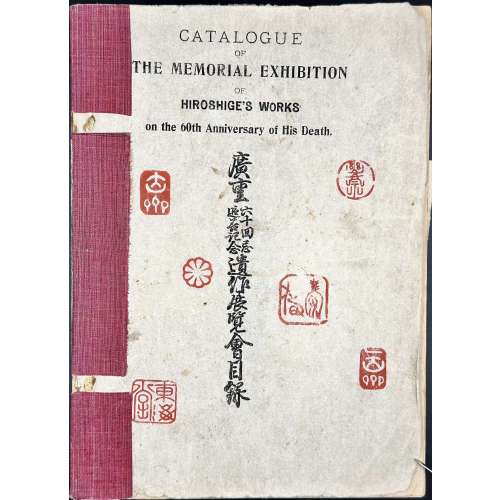 NEWPaperback volume with quarter red cloth backing 257 x 185 mm, black lettering in English and Japanese to front, red seals fac-simile to front and back; pp. [6] 1-6, 2-6 plates verso only, 7-26 [4] 1-66 [2] 7-88 plates verso only [2], some plates in colour with captioned tissue guards, incl. frontispiece memorial portrait of Utagawa Hiroshige [歌川 広重] a.k.a. Andō Hiroshige [安藤 広重] (Japanese, 1797 – 1858). Limited edition of 275 copies, this is copy № 254. Title-page: CATALOGUE | OF | THE MEMORIAL EXHIBITION | OF | HIROSHIGE'S WORKS | on the 60th Anniversary of His Death. | {red diamond} | Compiled and Published | BY | S. WATANABE. | (Ukiyoye Association) | TOKYO. | 1918. || Author: Shōzaburō Watanabe [渡辺 庄三郎] (Japanese, 1885 – 1962) Five fan prints: № 173. REFLECTED MOON ON THE SUMIDA. № 174. TOTO SHINAGAWA NO KEI. Shinagawa Beach, Yedo. № 179. ZUSÕ HAKONEYAMA YAKO NO ZU. Night Ascent of Hakone Pass. Published by Dansendo. № 180. TSUKI NO SANKEI. Beauties in a boat enjoying evening cool at Ryōgoku, from Three Moonlight Scenes. Published by Dansendo. № 182. SUMIDAGAWA HASHIBA WATASHI VUKI NO KEI. A Ferry Boat at a Sumida River Landing in Snow.
NEWPaperback volume with quarter red cloth backing 257 x 185 mm, black lettering in English and Japanese to front, red seals fac-simile to front and back; pp. [6] 1-6, 2-6 plates verso only, 7-26 [4] 1-66 [2] 7-88 plates verso only [2], some plates in colour with captioned tissue guards, incl. frontispiece memorial portrait of Utagawa Hiroshige [歌川 広重] a.k.a. Andō Hiroshige [安藤 広重] (Japanese, 1797 – 1858). Limited edition of 275 copies, this is copy № 254. Title-page: CATALOGUE | OF | THE MEMORIAL EXHIBITION | OF | HIROSHIGE'S WORKS | on the 60th Anniversary of His Death. | {red diamond} | Compiled and Published | BY | S. WATANABE. | (Ukiyoye Association) | TOKYO. | 1918. || Author: Shōzaburō Watanabe [渡辺 庄三郎] (Japanese, 1885 – 1962) Five fan prints: № 173. REFLECTED MOON ON THE SUMIDA. № 174. TOTO SHINAGAWA NO KEI. Shinagawa Beach, Yedo. № 179. ZUSÕ HAKONEYAMA YAKO NO ZU. Night Ascent of Hakone Pass. Published by Dansendo. № 180. TSUKI NO SANKEI. Beauties in a boat enjoying evening cool at Ryōgoku, from Three Moonlight Scenes. Published by Dansendo. № 182. SUMIDAGAWA HASHIBA WATASHI VUKI NO KEI. A Ferry Boat at a Sumida River Landing in Snow.



